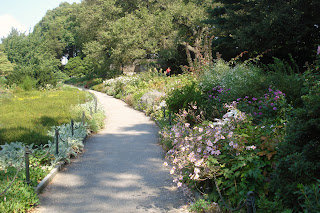 |
| The medicinal herb garden at The Cloisters in New York City. Copyright SHD 2011 |
 |
| Cloister from Saint-Michel-de-Cuxa The Cloisters, NYC copyright SHD 2011 |
The Cloisters museum and gardens in New York City is a branch of the Metropolican Museum of Art, located in Fort Tryon Park in northern Manhattan.
Located in a beautiful four-acre setting overlooking the Hudson River, The Cloisters was assembled from architectural elements from five medieval cloisters that date from the twelfth through the fifteenth century—Saint-Michel-de-Cuxa, Saint-Guilhem-le-Désert, Bonnefont-en-Comminges, Trie-en-Bigorre, and Froville—and from other monastic sites located in southern France.
Three of the cloisters feature gardens that were planted according to horticultural information found in medieval treatises and poetry, garden documents and herbals, and medieval works of art such as tapestries, stained-glass windows, and column capitals.
Three of the cloisters feature gardens that were planted according to horticultural information found in medieval treatises and poetry, garden documents and herbals, and medieval works of art such as tapestries, stained-glass windows, and column capitals.
 |
| Cloister from Bonnefont-en-Comminges The Cloisters, NYC copyright SHD 2011 |
(And don't let the entrance fee of $25 deter you, the Met has a "pay what you can afford" policy. Plus, entrance into either the Cloisters or The Met, gets you into the other for no extra charge. When I told the staffer that I was unemployed, and offered to pay only five dollars, he suggested that I could pay as little as one dollar. That helped me even more and allowed me to buy lunch and a few items in the gift shop.)
 |
| copyright SHD 2011 |
The walk is worth the effort, as the flowers and plants along the path are all derived from the medieval artworks contained in the Cloisters. Take the path and you will feel like you are beginning your travel back in time, and in a very short while you will come upon the ancient looking Monastery at the top of a hill.
 |
| The Cloisters, NYC, copyright SHD 2011 |
The medicinal herb garden at the Cloisters had many plants familiar to most gardeners and a few that were not so familar. I will be doing articles on them soon. One interesting plant that I noticed at the Cloisters was "Pellitory-of-the-Wall" (Parietaria officinalis), also known as Lichwort. They also had Valerian, Betony, Horehound, Clary Sage, Agrimony, Nightshade, Wormwood and Mandrake.
 |
| Nightshade copyright SHD 2011 |
Resources include:
The Cloisters at The Metropolican Museum of Art
Wikipedia
Walter Horn, "On the Origins of the Medieval Cloister"